Now & Then: Yamaha’s Historic Fours
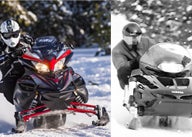
How Yamaha's four-cylinder motors made history
We never doubt Yamaha’s engineering prowess when it comes to concocting exceptional performance engines. Snowmobiling history abounds with tales of how in 1971 a small Team Yamaha 433cc twin powered Mike Trapp to a legendary World Championship Derby win over Team Ski-Doo’s Yvon Duhamel who piloted a 650 racer. It was the stuff of legends and is memorialized at the Snowmobile Racing Hall of Fame in St. Germain, Wis. Moving ahead to this century, Yamaha remains the only snowmobile manufacturer to ever produce a four-cylinder four-stroke in a high-performance snowmobile, the 2015 Apex series.
The Apex power dates back to the release of Yamaha’s RX-1 in 2003, the same season that Ski-Doo brought out its REV and re-invented the way we ride. Yamaha carried four-stroke snowmobile performance forward at a time when most sled makers saw four-strokes as necessary evils to meet EPA concerns. Yamaha met the EPA and added high performance.
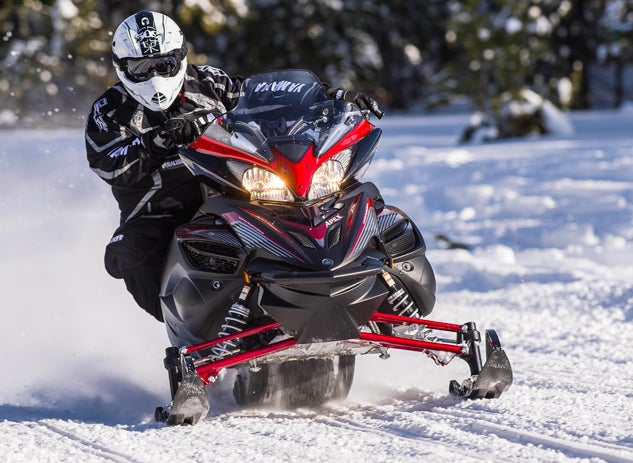 Yamaha’s Genesis 150 four-stroke brought four-cylinder performance into the new century.
Yamaha’s Genesis 150 four-stroke brought four-cylinder performance into the new century.Check out the current Apex with its 998cc Yamaha Genesis four-cylinder, which delivers more than 150 horsepower and utilizes an advanced electronically controlled EXUP exhaust monitored by onboard computers. This is the now of a Now and Then reality.
COMPARISON: Read our review of the 2014 Yamaha Apex
If the Yamaha Apex Genesis series four-cylinder is unique to modern snowmobiles, what of the original Yamaha four? The Vmax-4.
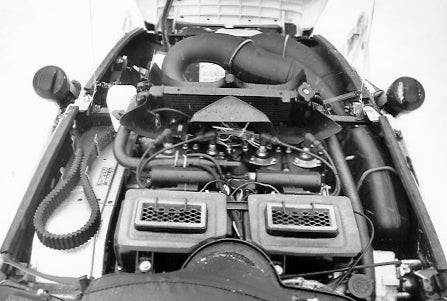 Yamaha’s Vmax-4 four-cylinder two-stroke measured 750cc and put out 115 estimated horsepower.
Yamaha’s Vmax-4 four-cylinder two-stroke measured 750cc and put out 115 estimated horsepower.The Vmax-4 hit the snows in 1992. It had a unique two-stroke engine displacing 743cc and sat transversely under the sloping hood of an all-new model. This inline four would be modified by Bender Racing to win its share of oval races, including competition at the same famed Eagle River track that saw the 433cc twin score Yamaha’s first major snowmobile victory in 1971.
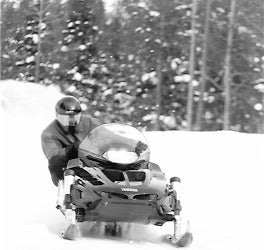 The power sled of the early 1990s, Yamaha’s Vmax-4 featured a four-cylinder two-stroke engine and telescopic strut front suspension.
The power sled of the early 1990s, Yamaha’s Vmax-4 featured a four-cylinder two-stroke engine and telescopic strut front suspension.Like the current Apex series, Yamaha’s 1992 Vmax-4 was all about performance. It marked Yamaha’s return to taking on all-comers – Ski-Doo’s Mach 1, Polaris’ Indy RXL and Arctic Cat’s Wildcat. Prior to the appearance of the Vmax-4, Yamaha settled for corner-to-corner acceleration, which was very good, but in the battle for performance customers it was horsepower and cubic displacement that mattered most. The Vmax-4 was two cylinders and about 200cc bigger than its previous performance models. It was designed to make a statement, and like the RX-1 a decade later, it did!
When the Vmax-4 appeared, it carried the largest displacement engine of any production sled in snowmobile-dom. The only company fully capable to retaliate would be Rotax, Ski-Doo’s in-house engine builder. But at the time of its introduction, Yamaha’s 750 four-cylinder was – and remains – unique.
Because the motor paired its two sets of heads close together and left space in the middle, it looked like two twins joined together. That middle gap housed the liquid-cooled design’s gear housing, which powered the oil injection pump and water pump. The engine displaced 743cc from a bore and stroke of 63mm by 59.6mm.
Yamaha used a digital ignition system of the same type as in its Exciter II model. Fuel to the four Mikuni flatslide 33mm carburetors came from dual Mikuni fuel pumps. With a compression ratio of 6.3:1, the engine operated easily on standard 87 octane fuel.
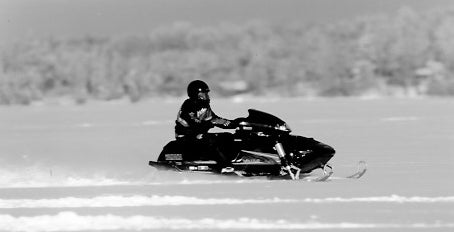 Vmax-4 power made short runs out of long lake beds back in the early 1990s.
Vmax-4 power made short runs out of long lake beds back in the early 1990s.In on-snow test riding at the time, the Vmax-4 was said to have “…a smoothness at virtually all speeds.” Test riders commented that the sled felt turbine-smooth with no rough spots, “…like a jet rolling out for a take-off.”
The four-cylinder Vmax-4, although a two-stroke, shared a similar power delivery with the easy-response of the current-day Apex. Yamaha excels in building smooth, powerful engines for performance-minded riders. It also utilizes clever engineering. The end result, although broken up by a decade, has been shared to provide ample low end torque and eye-watering top speed. The Vmax-4 also had a distinctive note, perhaps not the screaming pitch of the four-stroke Apex, but unlike any other sled engine of its day. Unlike the Apex, the Vmax-4 exhaust consisted of two-into-one headers dumping into a pair of tuners, which in turn emptied into a single canister silencer. Compare that to the modern Apex’ four-into-two pipes running straight back under the seat.
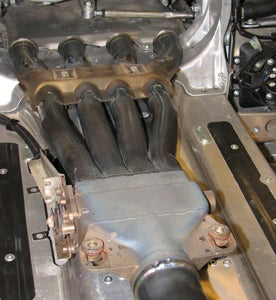 Yamaha’s modern Apex four-cylinder motor features dual four-into-two exhaust that exist under the seat.
Yamaha’s modern Apex four-cylinder motor features dual four-into-two exhaust that exist under the seat.Yamaha engineers didn’t ever really worry about what the other guys were doing. They had their own thoughts on performance that came from experience in building a V-12 for Brabham’s Formula One team, enhancing the power for Ford’s high-performance Taurus SHO and a line of world championship road racing motorcycles. After the Vmax-4 showed up, the other sled makers added cylinders and displacement to some performance models, including a new Arctic Cat ZRT three-cylinder and Ski-Doo’s own Formula III. Of course, the horsepower wars of the 1990s were casual by today’s standards. The Vmax-4 rated about 115 to 120 horses, which would make it comparable to a modern 600cc two-stroke.
Unlike the double A-arm front suspension of the 2015 Apex, Yamaha’s Vmax-4 featured a non-traditional front end, even by 1990s standards. The exclusive-to-Yamaha telescoping front suspension first surfaced on fan-cooled Phazers years earlier. By the time that TSS was applied to the Vmax-4, Yamaha engineers had gotten it well tuned, especially in the hands of its top racers. The system worked well enough, but by the time Yamaha moved forward with the 2003 RX-1, the engineering crew decided that a more conventional double A-arm front end made more sense and has continuously improved it up to the current 2015 Apex series.
While the 2015 Apex may be more conventional in its suspensions, the underhood engineering still sets Yamaha apart as much now as it did back in 1992. Only Yamaha has produced serious four-cylinder engines for snowmobiling. It didn’t matter whether those engines were two- or four-stroke designs, they all produced excellent power, offered excellent longevity and embellished the Yamaha reputation.
| 2015 Yamaha Apex | 1992 Yamaha Vmax-4 | |
| Engine | Yamaha four-stroke “top-performance” 998cc; bore/stroke of 74.0mm/58.0mm; four-cylinder, liquid-cooled; 4 liquid-heated 39mm throttle bodies; electronic fuel injection system; rear-exiting, underseat exhaust | Yamaha two-stroke “top-performance” 743cc; bore/stroke of 63.0mm/59.6mm; 4-cylinder, liquid-cooled; four TM 33mm flatslide Mikuni carbs |
| Horsepower | 160-plus (claimed) | 128+ |
| Drive | Yamaha YVXC drive clutch with Yamaha driven | Yamaha Xtra Ratio drive clutch with Yamaha driven; 3,500 rpm engagement; 8,300 shift rpm |
| Front Suspension | Yamaha A-arm with 40mm HPG aluminum shocks; up to 8.5-in of travel | Yamaha Telescopic Strut with compression adjustment; up to 8.5-in of travel |
| Rear Suspension | Yamaha MonoShock II RA parallel slide rail with 46mm aluminum “clicker” gas shock; up to 11.6-inches of travel | Yamaha progressive link; dual gas shocks; up to 7.8-inches of travel |
| Length | 110.8 in | NA |
| Height | 47.6 in | NA |
| Width | 47.3 in | |
| Ski Stance | 42.5 in | NA |
| Track | 15 x 128 x 1.25 Camoplast Rip Saw | 15 x 121 rubber |
| Brake | Four-piston hydraulic disc brake with ventilated lightweight rotor | Hydraulic disc brake with ventilated lightweight rotor |
| Weight | NA | 540 (claimed) |
| Fuel Capacity | 9.2 US Gal (regular fuel) | Regular fuel |
| Features | Electric power steering, Electric start, reverse, LCD speedometer/odometer, halogen headlight, DC Outlet, one-year limited factory warranty | Speedometer/odometer, headlight, nitrogen charged shocks |
| MSRP | $14,149 | $8,500 |




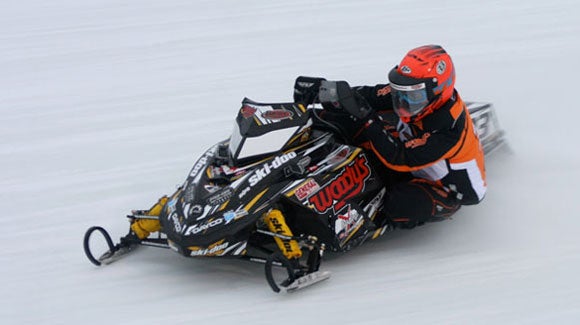



 Your Privacy Choices
Your Privacy Choices